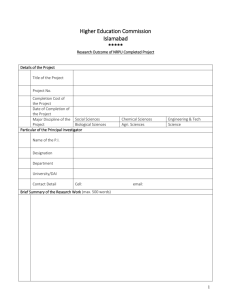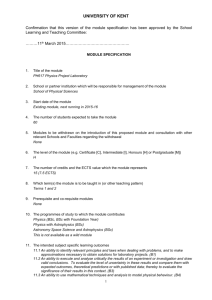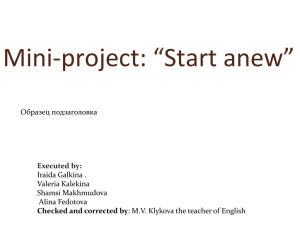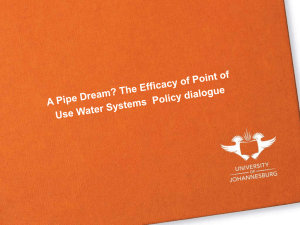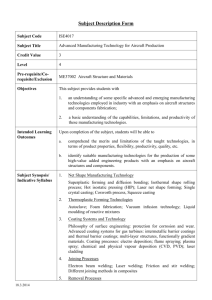ISE5001
advertisement
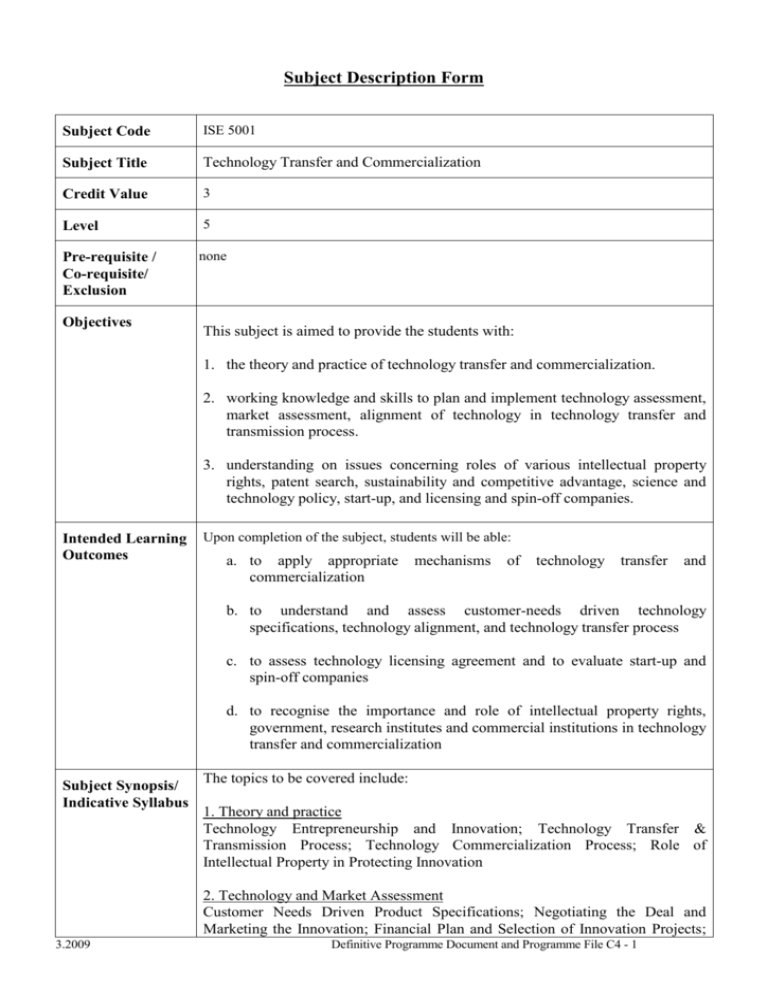
Subject Description Form Subject Code ISE 5001 Subject Title Technology Transfer and Commercialization Credit Value 3 Level 5 Pre-requisite / Co-requisite/ Exclusion none Objectives This subject is aimed to provide the students with: 1. the theory and practice of technology transfer and commercialization. 2. working knowledge and skills to plan and implement technology assessment, market assessment, alignment of technology in technology transfer and transmission process. 3. understanding on issues concerning roles of various intellectual property rights, patent search, sustainability and competitive advantage, science and technology policy, start-up, and licensing and spin-off companies. Intended Learning Outcomes Upon completion of the subject, students will be able: a. to apply appropriate commercialization mechanisms of technology transfer and b. to understand and assess customer-needs driven technology specifications, technology alignment, and technology transfer process c. to assess technology licensing agreement and to evaluate start-up and spin-off companies d. to recognise the importance and role of intellectual property rights, government, research institutes and commercial institutions in technology transfer and commercialization Subject Synopsis/ Indicative Syllabus The topics to be covered include: 1. Theory and practice Technology Entrepreneurship and Innovation; Technology Transfer & Transmission Process; Technology Commercialization Process; Role of Intellectual Property in Protecting Innovation 2. Technology and Market Assessment Customer Needs Driven Product Specifications; Negotiating the Deal and Marketing the Innovation; Financial Plan and Selection of Innovation Projects; 3.2009 Definitive Programme Document and Programme File C4 - 1 Innovation and Risk Management; Technology Valuation and Impact Analysis; Market Assessment and Alignment of Technology. 3. Commercialization Strategy Coming Full Circle in the Commercialization Loop; Business Plan Science and Technology Policy; Negotiating and Monitoring the Licensing Agreement; StartUp and Spin-Off Companies; Joint Venture. 4. Case Studies Case studies drawn from commercial, industrial and research applications. Teaching/Learning This subject is offered in block mode format on weekends, usually spread over a Methodology month. A mixture of lectures, tutorial exercises, and case studies will be used to deliver the various topics in this subject. Some of the topics will be covered in a problem-based format where this enhances the learning objectives. Others will be run as project-based, whereby students will learn and apply the knowledge and techniques to solving real problems. The subject also emphases experiential learning offered by industrial leaders. Assessment Methods in Alignment with Intended Learning Outcomes Specific assessment methods/tasks % Intended subject learning outcomes to be weighting assessed (Please tick as appropriate) a b c d 1. Individual Assignment 25 % 2. In-class exercises 20 % 3. Quiz and Test 35% 4. Individual presentation for mini-project 10 % 5. mini-project report 10 % Total 100 % This is a 100% continuous assessment subject which is comprised of assignments with individual and group components, mini-project and usually two tests. All assessment components will require students to apply what they have learnt to realistic work applications. To assess the learning outcomes (a) to (b) of the students, the students are required to form a group to work on a mini-project. The students are provided with a simulated environment for demonstrating their understanding and capability in integrating and applying concepts and skills learnt in the class in analyzing, solving problems in real life. The individual assignment allows the students to reflect their understanding of 3.2009 Definitive Programme Document and Programme File C4 - 2 the topics expected in learning outcome (b) and (d). The in-class exercises allow the students to give quick feedback on applying and practicing the techniques learnt in the classes for learning outcomes (a) and (c). There are a quiz and a test which aim to assess the overall understanding of the student for the concepts and knowledge necessary for achieving learning outcomes (a) to (d) Student Study Effort Required Class contact: Lectures 28 Hrs. In-class activities/Tutorial 14 Hrs. Other student study effort: Study and self learning including mini-project and preparation for mini-project presentation Assignment and report writing Total student study effort Reading List and References 3.2009 38 Hrs. 25 Hrs. 105 Hrs. 1. Clifford, M. Gross and Joseph P. Allen, (2003) “Technology Transfer for Entrepreneurs – A Guide to Commercializing Federal Laboratory Innovation”, Praeger Publishers, USA. 2. Cohen, M. W., “Patents and Appropriation_ Concerns and Evidence”, Journal of Technology Transfer, 30(1&2): 57-71, 2005. 3. Cooke, I. and Mayes, P. (1996), Introduction to Innovation and Technology Transfer, Norwood: Artech House. 4. Dorf, R.C. (1999), The Technology Management Handbook, Boca Raton, Fla.: CRC Press. 5. Eskelin, A. (2001), Technology Acquisition: Buying the Future of your Business, Boston, Mass.: Addison-Wesley. 6. Farris, G.F., “Research in Innovation Management and Technology Transfer in China”, The Journal of Technology Transfer, 32(1-2) 123126, April 2007. 7. Iansiti, M. (1998), Technology Integration: Making Critical Choices in a Dynamic World, Mass.: Harvard Business School. 8. Inzelt, A. and Hilton, J. (1999), Technology Transfer: From Invention to Innovation, Kluwer Academic, Norwell. 9. Jolly, V.K (1997), Commercialisation of New Technologies, Greeting from Mind to Market, Boston, Mass.: Harvard Business School Press. 10. Melissa, A. Schilling (2008), Strategic Management of Technology Innovation, Micraw-Hill International Edition, 2nd Edition, Singapore. 11. Muir, A.E. (1997), The Technology Transfer System, New York: Latham Book Publishing. 12. Parr, R.L. and Sullivan, P.H. (1996), Technology Licensing: Corporate Strategies for Maximizing Value, New York: John Wiley & Sons. 13. Paulson, E. (2001), The Technology M&A Guidebook, New York: John Wiley & Sons. 14. Megantz, R.C. (2002), Technology Management: Developing and Implementing Effective Licensing Programs, New York: John Wiley & Definitive Programme Document and Programme File C4 - 3 Sons. 15. Spencer, R.H. (2003), Technology Best Practices, New York: John Wiley & Sons. 16. Timmons, J.A. (2003), New Venture Creation, Sixth edition, Chicago: Irwin. 17. Protecting Innovations by Utility Models (http://www.wipo.int/sme/en/ip_business/utility_models/utility_models.h tm). 18. NASA’s Technology Transfer Spin-Out Process (http://ipp.gsfc.nasa.gov/resources-ttprocess2.html). 19. Ramsey. W.S., “Financing a New Venture”, http://www.williamramseylaw.com/pages/Pfinancing.html 3.2009 Definitive Programme Document and Programme File C4 - 4
